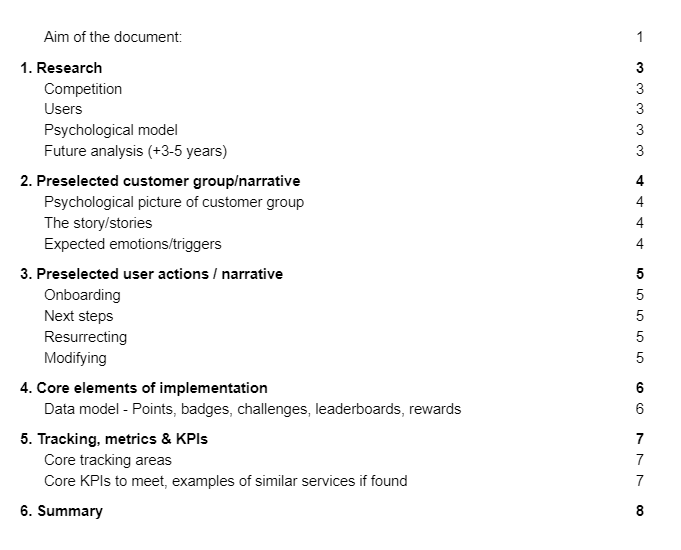Every gamification strategy starts with a solid research. To create a map, you not only need to know where you want to end up, but also where you are. In other words: you need to get to know your users, and potential users, their behaviour, their language, their emotons. All this will come together and help you design a correct behavioral goals and then gamification elements.

Over the years of consulting for multiple different companies from various industries, I have come up with this simple starter template, that helps me ensure solid quality of my research and provides a good structure for future conclusions.
How to do research for gamification?
Research is one of the biggest elements of the gamification strategy design.
First, I like to start with competition. What do others offer? What paths they create? Maybe they already gamify some elements of the customer journey?
Typically, I list out about 5-10 competing companies, showcase their good and weak sides, I also notice differences, or elements that I think might be source of conversion / user reaction. (For example using animated button, or being able to order without creating an account)
Then I look at the users of these companies. I check social media, hashtags, how do they speak? What language do they use? Are they happy with the services or goods they are purchasing? What emotional state they are in when interacting with the brands?
Then I create a simple psychological model, where I try to create a short version of "who user is".
The last step is future analysis. I want my strategy to be valid for years ahead without major changes. This is why I try to predict what kind of megatrends might impact this business, and what should be taken into consideration.
After the research part is done, I usually schedule feedback session with the customer, to exchange observations and experiences. Usually customer can point one or two new cases worth analysis.
How to move from research to actual users?
Second part of my research is usually about customer groups. Having the knowledge about the market and general view of who is interacting with the product/service/app, I can preselect distinct customer groups, who would be using the service.
Usually, these groups are split by age, but not always. Around those groups, I create "the story" which puts this imaginary user into perspective of real life situation and helps us better understand the emotions and triggers this group might experience.
Defining the right emotion set for a customer group is critical before starting to think about any gamification techniques. User groups that are not competitive, might not like leaderboards, and user groups who are very risk awerse, will not want random elements in their experience.
We know users and their emotions, whats next?
Then we actually start to design the user flow. What is he experiencing from day one - from the first click in the app.
We start with the strongest emotional factor, and offer variety of other elements as added options.
We know who is the user and how it feels, and through creating a real story, real challenge, we shift his emotional state into desired one and trigger action.
I like to split this part of research into 4 groups:
- Onboarding - what is happening during the first visit
- Next steps - how we want the user to communicate with our service moving on
- Resurrection - what will we do, to bring users back
- Modification - what will we be changing if system wouldn't work as expected
Core elements of gamification
Points, badges, challenges, leaderboards, rewards - all these should not be considered before the research above is complete. Once that is done, they seem almost natural and this part seems to be the easiest.
Here we not only decide what gamifiaction techniques we will use, but also how we are going to balance the system, and ensure players are having fun but still being profitable.
Measure what matters
It is very important to decide what will be measured early on. Those measurments will help us understand whether the system is performing properly, or needs changes and adjustments
Summary
I hope I was able to show you how to do gamification research for your company. As you can see the gamification part is not taking even 30% of time here. The most important part of it is getting to know actual users, their habits, their behaviors, their history and their emotions.
If you need any help in defininig your gamification strategy, don't hesitate to reach out!